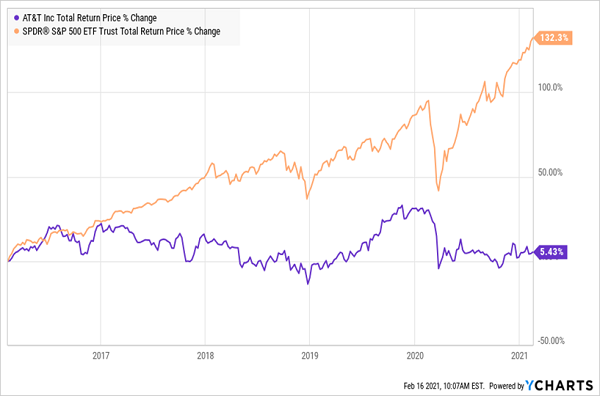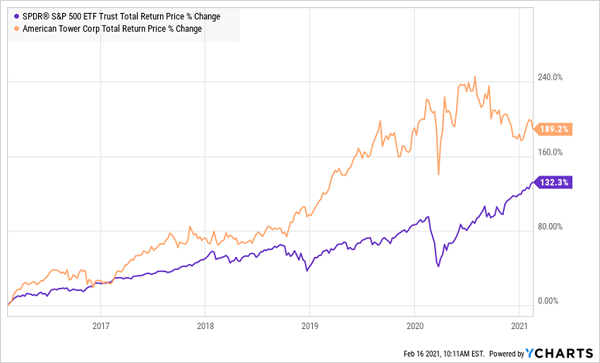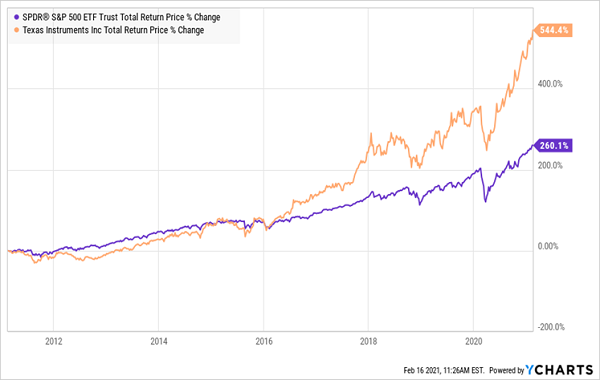The S&P 500 is still levitating, and if you’re like me, you’re starting to feel like this bull run is on borrowed time.
It’s understandable. The economy is just now stumbling to its feet, yet interest rates are already creeping higher. I think you’ll agree that we need higher borrowing costs like we need a hole in the head!
Treasury Rates Bust Through the 1% Barrier

Sure, 1.2% is a historically low number, but bear in mind 1% is an important psychological barrier, and we’re already well beyond that—and once rates broke through it, you can see how quickly they took off. It’s entirely possible they’ll be off to the races in the next few months, taking rates on mortgages, car loans and lines of credit with them.
But it’s not all doom-and-gloom. As I write this, lockdown restrictions have recently eased (yet again) here in California. And well over a million Americans are getting vaccinated daily.
That brings us to a critical question: how the heck do we invest through this transitional market? I’ve got a three-point plan for you that works in any economy—not just the Twilight Zone one we’re living in now.
Step 1: Start With “Tollbooth Stocks”
Tollbooth stocks are the kinds of companies we safety-conscious dividend investors love: they hold the infrastructure—think pipelines, warehouses and data networks—big players like, say, Amazon (NASDAQ:AMZN) must have to operate.
These quiet “toll collectors” hand over most of the cash they collect to us as dividends. Another benefit of these stocks is that buying them is much safer than trying to pick individual winners in competitive industries.
To show you what I mean, let’s say that, five years ago, you wanted to buy into the trend toward surging mobile-device use and data consumption. You could have bought the go-to US telecom stock, AT&T(NYSE:T), which is renowned for high yields: it paid around 5.5% back then.
But that high yield wouldn’t have saved you from a lousy return. In the last five years, AT&T has been run over by the S&P 500—even with dividends included!
Popular Telecom Pick Flops

What about Verizon Communications (NYSE:VZ)? It typically yields a bit less than AT&T. But it did add some price gains in the last five years—enough to push it past Ma Bell’s stock. But it still got run over by the S&P 500:
Verizon Does a Bit Better, But It’s Still “Dead Money”

Now let’s compare this duo to our tollbooth play, American Tower (NYSE:AMT), a real estate investment trust (REIT) with 181,000 cell towers around the world. All the major telcos pay “rent” to AMT, including AT&T and Verizon.
The stock roared past both of them—and the market, to boot!
This Tollbooth Play Is Anything But Boring

American Tower is just one example of an effective tollbooth play. There are plenty more out there, including pipelines, owners of corporate data centers (more on that in a second) and utilities.
Step 2: Add Growth With “Relative Strength”
Tollbooth plays can provide a great base for your portfolio. Now let’s add upside (in both share prices and dividends) with stocks showing what I call “relative strength.”
Relative strength means that strong stocks tend to stay strong, giving them a solid base from which to jump. Forget the bargain bin—we’re not looking for low P/E ratios here—just stocks that have momentum.
Everybody loves betting on a long shot, but the trouble is, these underdogs simply don’t come in enough to pay. We like strong stocks, smart management and megatrends. But everybody wants those, so where do we find our edge?
In two places:
- We find underappreciated and hence undervalued stocks in popular sectors. Think: firms with a technology edge that are not—yet!—priced like go-go tech stocks.
- Or we look at an out-of-favor sector and find a stock that has been mislabeled.
Giant semiconductor maker Texas Instruments (NASDAQ:TXN) provides a good example of the kind of fast return a relative-strength stock can deliver.
Below is a chart of TXN’s performance over the last decade. You can see that the stock more or less tracked the market for half of that time before setting up and then sprinting past the benchmark in early 2016.
TXN Plants Its Flag

With the pattern firmly established, I recommended TXN in my Hidden Yields service in June 2017. The result? The stock recently smashed through my $170 “buy up to” price (meaning I no longer recommend it for new buying), handing us a 149% total return in about three-and-a-half years. That’s nearly double the S&P 500’s 73% gain!
Now let’s move on to the final key in our dividend-investing plan:
Step 3: Take Out Some Inflation “Insurance”
With 10-year Treasury rates rolling higher and the Fed’s money-printing quantitative easing likely to stick around, it doesn’t hurt to build some inflation protection into our portfolios.
Most investors think gold is the best inflation hedge, but it doesn’t work for us because coins and bars don’t pay dividends. (In fact, you’ll probably have to pay to store them.) Gold miners aren’t exactly dividend machines, either. Major producer Newmont Corp (NYSE:NEM) yields just under 2% as I write this.
Instead, we’ll look for stocks with:
- Dividends that outrun inflation: To maintain our lead over rising prices, we need stocks with growing—and ideally accelerating—payout growth. Steady dividend growth grows your yield on cost over time. That can mean that a 3% current yield could grow to 6%, 8% or even 10%+ years down the road. (I’ll show you this yield gain in action below.)
- A low beta rating: Beta is a volatility measure. A rating below 1 means a stock is less volatile than the S&P 500; above 1 is more volatile. We want a rating of 1 or below so we can enjoy our dividends in peace.
A good place to hunt for stocks that tick these two boxes is back in the REIT space. Beyond cell-tower landlords, you could look to REITs running another piece of critical infrastructure: corporate data centers, which house the servers companies need to keep running, especially in this era of remote work.
Data-center landlord Equinix (NASDAQ:EQIX), for example, pays a dividend that’s surged 64% in the last five years. That spectacular payout growth means folks who bought back then don’t care a bit about the 1.5% yield the stock offers today—the inflated dividend they’re collecting now amounts to a much bigger percentage of their original purchase price—5.8%, to be exact!
They’ve also seen a strong gain as investors have followed that surging dividend and bought the stock, driving it up a stunning 142% in that time.
Finally, the beta rating—Equinix’s five-year beta is 0.32, meaning the stock is 68% less volatile than the S&P 500. That means an investor can enjoy their growing payouts with much less risk of the stock price falling out from under them.
Disclosure: Brett Owens and Michael Foster are contrarian income investors who look for undervalued stocks/funds across the U.S. markets. Click here to learn how to profit from their strategies in the latest report, "7 Great Dividend Growth Stocks for a Secure Retirement."
